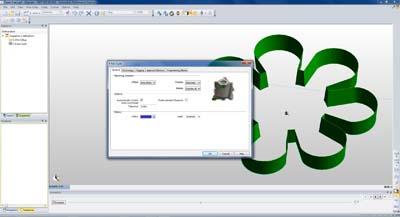
Edgecam 2013 R1 from Vero Software provides an intuitive environment for the comprehensive programming of all wire EDM machine tools. It includes a comprehensive library of proven post-processors and knowledge-based cutting schemes as standard. The new cycles are aware of stock, eliminating air cuts and reducing cycle time.
Users can select from one of the pre-defined machining strategies, such as "Unattended night runs" and "Attended day runs." Alternatively, they can easily define their own.
Other features include multiple strategies for corner types, different tagging options, the ability to apply roughing and finishing cuts, multiple punches and dies, and a "no core" pocket destruction routine. Another new feature is the "Images and context help" for all options on the Wire and Feature Find command dialogs, which makes the interface more intuitive, and helps users to better understand their purpose.
As well as the new wire EDM function, a number of enhancements gives added value for all Edgecam users:
Waveform Roughing cycle now has the ability to specify a pre-drilled hole as the approach type, ensuring a smoother transition into the material, reducing the cycle time even further.
Another time-saving feature in the Profiling cycle is the new option to specify a chamfer or radius to break sharp corners, eliminating the need for deburring.
A new "Tube" stock type has been added, and the user can now edit stock dimensions and re-pick geometry while retaining the stock shape. Changes to the stock are now considered automatically when regenerating the machining instructions.
In Feature Finder, improved ordering based on a "nearest next" algorithm ensures that features are presented in optimal order for machining. Feature Finder can now also identify U and V shaped groves for subsequent machining.
In Turning, the new Rough Profiling cycle removes material in a series of cuts parallel to the input profile, and is typically used for roughing free form profiles from castings and forgings. It is also useful for cutting materials where it is beneficial to minimise re-entrant cutting as it keeps the tool in contact with the material for longer. The cycle includes intelligent stock entry and exit, as well as being stock-aware to eliminate air cuts and reduce cycle time, along with supporting controller tool offsets and including options to specify a range of different offsets.
Further enhancements have been made to the Edgecam Simulator, enabling the simulation process to rewind to a previous position in the machining sequence.
Toolpaths are now generated much faster thanks to a new 5-axis 64-bit machining engine running as a separate process, utilising multiple core technology. Background processing of milling cycles in the Mill/Turn environment is now available, meaning the user can carry on working while Edgecam calculates complex toolpaths.
Edgecam is a certified partner for Autodesk Inventor, and 2013 R1 contains a direct interface with Autodesk Vault 2013, allowing users to manage their Edgecam files in it. Work in progress can be tracked, and users can maintain version control over their individual jobs.
Edgecam's Vault menu gives direct access, and users can check part files in and out, and view the change history. When Edgecam files containing an Inventor model are checked out of the Vault and loaded into Edgecam, any recent changes to the Inventor model are recognised, flagging up the opportunity to update it in the Edgecam part.
Contact Details
Related Glossary Terms
- electrical-discharge machining ( EDM)
electrical-discharge machining ( EDM)
Process that vaporizes conductive materials by controlled application of pulsed electrical current that flows between a workpiece and electrode (tool) in a dielectric fluid. Permits machining shapes to tight accuracies without the internal stresses conventional machining often generates. Useful in diemaking.
- gang cutting ( milling)
gang cutting ( milling)
Machining with several cutters mounted on a single arbor, generally for simultaneous cutting.
- milling
milling
Machining operation in which metal or other material is removed by applying power to a rotating cutter. In vertical milling, the cutting tool is mounted vertically on the spindle. In horizontal milling, the cutting tool is mounted horizontally, either directly on the spindle or on an arbor. Horizontal milling is further broken down into conventional milling, where the cutter rotates opposite the direction of feed, or “up” into the workpiece; and climb milling, where the cutter rotates in the direction of feed, or “down” into the workpiece. Milling operations include plane or surface milling, endmilling, facemilling, angle milling, form milling and profiling.
- parallel
parallel
Strip or block of precision-ground stock used to elevate a workpiece, while keeping it parallel to the worktable, to prevent cutter/table contact.
- profiling
profiling
Machining vertical edges of workpieces having irregular contours; normally performed with an endmill in a vertical spindle on a milling machine or with a profiler, following a pattern. See mill, milling machine.
- turning
turning
Workpiece is held in a chuck, mounted on a face plate or secured between centers and rotated while a cutting tool, normally a single-point tool, is fed into it along its periphery or across its end or face. Takes the form of straight turning (cutting along the periphery of the workpiece); taper turning (creating a taper); step turning (turning different-size diameters on the same work); chamfering (beveling an edge or shoulder); facing (cutting on an end); turning threads (usually external but can be internal); roughing (high-volume metal removal); and finishing (final light cuts). Performed on lathes, turning centers, chucking machines, automatic screw machines and similar machines.
- wire EDM
wire EDM
Process similar to ram electrical-discharge machining except a small-diameter copper or brass wire is used as a traveling electrode. Usually used in conjunction with a CNC and only works when a part is to be cut completely through. A common analogy is wire electrical-discharge machining is like an ultraprecise, electrical, contour-sawing operation.
